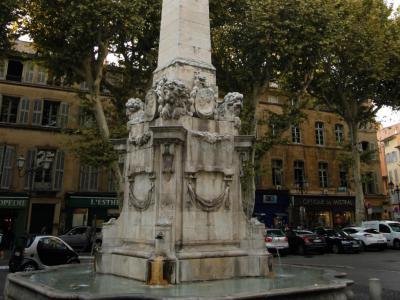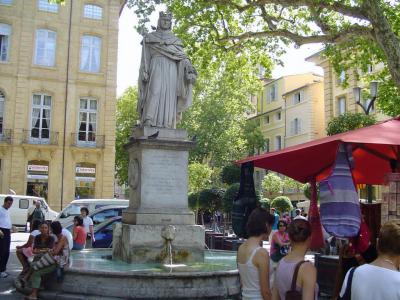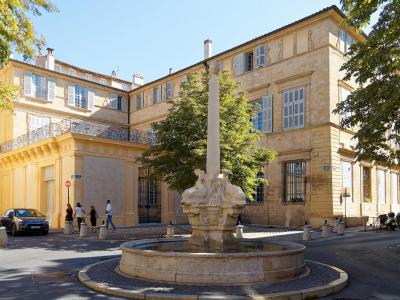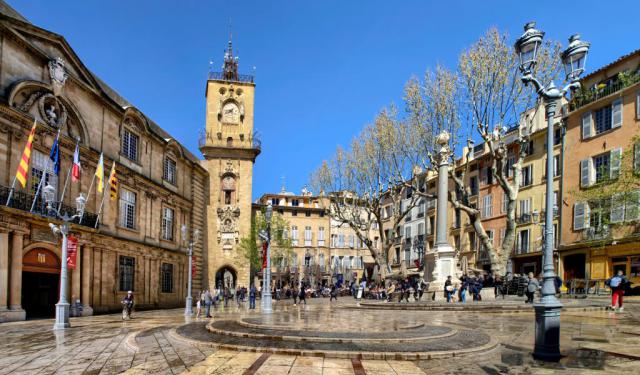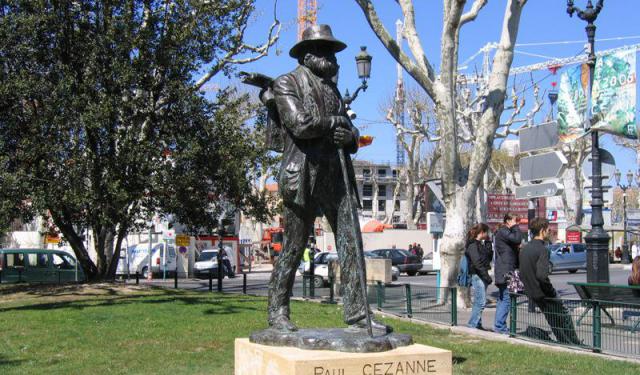
Aix-en-Provence Fountains and Squares Tour (Self Guided), Aix-en-Provence
Aix-end-Provence is known for its fountains. With more than 1,000 fountains, a tourist could spend weeks walking around the city without glimpsing them all. The fountains began appearing under the Roman empire when the Romans discovered Aix's natural thermal water source. They referred to the area as Aquae Sextiae or the Waters of Sextius.
The fountains appear throughout the city and are prominent features in many of the squares. There are unique fountains like the Boar Fountain found at Richelme Square and more traditional fountains, like the one seen at Place des Trois Ormeaux. The larger-than-life obelisk at Place des Precheurs has fountains at its base, while Place et Fontaine d'Albertas is as known for the large, central fountain as it is for the square itself.
Other fountains popular among visitors are the Fontaine des Augustins (Fountain of the Augustins), Fontaine de la Rotonde (Fountain of the Rotunda), Fontaine des Neuf-Canons (Fountain of the Nine Cannons), Fontaine du Roi Rene (King Rene Fountain) and Fontaine Moussue (Mossy Fountain).
Arguably one of the most famous fountains in the city is Fontaine des Quatre Dauphins. This fountain was the first free-standing fountain in Aix-en-Provence. It was built by Jean-Claude Rambot in 1667.
Take this self-guided walking tour to see the beautiful fountains and squares of Aix-en-Provence.
The fountains appear throughout the city and are prominent features in many of the squares. There are unique fountains like the Boar Fountain found at Richelme Square and more traditional fountains, like the one seen at Place des Trois Ormeaux. The larger-than-life obelisk at Place des Precheurs has fountains at its base, while Place et Fontaine d'Albertas is as known for the large, central fountain as it is for the square itself.
Other fountains popular among visitors are the Fontaine des Augustins (Fountain of the Augustins), Fontaine de la Rotonde (Fountain of the Rotunda), Fontaine des Neuf-Canons (Fountain of the Nine Cannons), Fontaine du Roi Rene (King Rene Fountain) and Fontaine Moussue (Mossy Fountain).
Arguably one of the most famous fountains in the city is Fontaine des Quatre Dauphins. This fountain was the first free-standing fountain in Aix-en-Provence. It was built by Jean-Claude Rambot in 1667.
Take this self-guided walking tour to see the beautiful fountains and squares of Aix-en-Provence.
How it works: Download the app "GPSmyCity: Walks in 1K+ Cities" from Apple App Store or Google Play Store to your mobile phone or tablet. The app turns your mobile device into a personal tour guide and its built-in GPS navigation functions guide you from one tour stop to next. The app works offline, so no data plan is needed when traveling abroad.
Aix-en-Provence Fountains and Squares Tour Map
Guide Name: Aix-en-Provence Fountains and Squares Tour
Guide Location: France » Aix-en-Provence (See other walking tours in Aix-en-Provence)
Guide Type: Self-guided Walking Tour (Sightseeing)
# of Attractions: 10
Tour Duration: 1 Hour(s)
Travel Distance: 1.6 Km or 1 Miles
Author: nataly
Sight(s) Featured in This Guide:
Guide Location: France » Aix-en-Provence (See other walking tours in Aix-en-Provence)
Guide Type: Self-guided Walking Tour (Sightseeing)
# of Attractions: 10
Tour Duration: 1 Hour(s)
Travel Distance: 1.6 Km or 1 Miles
Author: nataly
Sight(s) Featured in This Guide:
- Richelme Square and the Boar Fountain
- Place des Trois Ormeaux (Three Elms Square)
- Place des Prêcheurs (Preachers Square)
- Place et Fontaine d'Albertas (Albertas Square and Fountain)
- Fontaine des Augustins (Fountain of the Augustins)
- Fontaine de la Rotonde (Fountain of the Rotunda)
- Fontaine des Neuf-Canons (Fountain of the Nine Cannons)
- Fontaine Moussue (Mossy Fountain)
- Fontaine du Roi René (King Rene Fountain)
- Mazarin District and Fountain of the Four Dolphins
1) Richelme Square and the Boar Fountain
Richelme Square (Place Richelme) is widely known as the oldest and one of the most beautiful squares in Aix-en-Provence. The centrally-located square is surrounded by buildings with gilded facades and looming trees that cast comforting shadows.
During the daytime, Richelme Square hosts a food market that has been around since the 14th century. While the square is popular with tourists, most shoppers are locals. Visitors can enjoy shopping alongside residents before sitting at one of the tables to enjoy a picnic lunch.
The daily food market closes every evening. Richelme Square then becomes a spot for dining or having drinks. It is not a party atmosphere but an elegant place to relax.
The Boar Fountain (Fontana del Porcellino di Aix) is a primary feature of Richelme Square. The giant bronze boar is fashioned after a 17th-century statue in Florence, Il Porcellino (Italian "piglet"). The Boar was first displayed at the Town Hall, then moved to Richelme Square in the 1980s. It is situated outside the upmarket food chain, The Daily Bread (Le Pain Quotidien). The Boar Fountain is a great place to meet friends after browsing the market.
During the daytime, Richelme Square hosts a food market that has been around since the 14th century. While the square is popular with tourists, most shoppers are locals. Visitors can enjoy shopping alongside residents before sitting at one of the tables to enjoy a picnic lunch.
The daily food market closes every evening. Richelme Square then becomes a spot for dining or having drinks. It is not a party atmosphere but an elegant place to relax.
The Boar Fountain (Fontana del Porcellino di Aix) is a primary feature of Richelme Square. The giant bronze boar is fashioned after a 17th-century statue in Florence, Il Porcellino (Italian "piglet"). The Boar was first displayed at the Town Hall, then moved to Richelme Square in the 1980s. It is situated outside the upmarket food chain, The Daily Bread (Le Pain Quotidien). The Boar Fountain is a great place to meet friends after browsing the market.
2) Place des Trois Ormeaux (Three Elms Square)
The Three Elms Square (Place des Trois Ormeaux) is a small town square near the center of Aix-en-Provence. It was named after its fountain, the Three Elms Fountain, which, in turn, was named for three elms planted in a triangle at each corner of the plaza.
There is a legend that the elms magically grew in an area where local soldiers took up arms against the ruler of Aix. Though the square remains named The Square of the Three Elms, the elm trees were removed and replaced with plane trees. Three Elms Square was previously named for the Consul of Aix-en-Provence, Bertrand Berici, who lived here at the beginning of the 15th century.
The fountain, made from Calissane and Bibemus stone, stands in the center of the square. The 17th-century fountain has a polygonal base with a central pedestal from which the water flows out of six cannons. The pedestal is carved with a floral motif, and vine leaves with a sublime bunch of grapes at the top. The fountain has stood the test of time with modesty and simple beauty.
The Three Elms Square is surrounded by houses, shops, and restaurants. Tourists should pay close attention to the door of the Saphallin Hotel, which dates to 1672.
There is a legend that the elms magically grew in an area where local soldiers took up arms against the ruler of Aix. Though the square remains named The Square of the Three Elms, the elm trees were removed and replaced with plane trees. Three Elms Square was previously named for the Consul of Aix-en-Provence, Bertrand Berici, who lived here at the beginning of the 15th century.
The fountain, made from Calissane and Bibemus stone, stands in the center of the square. The 17th-century fountain has a polygonal base with a central pedestal from which the water flows out of six cannons. The pedestal is carved with a floral motif, and vine leaves with a sublime bunch of grapes at the top. The fountain has stood the test of time with modesty and simple beauty.
The Three Elms Square is surrounded by houses, shops, and restaurants. Tourists should pay close attention to the door of the Saphallin Hotel, which dates to 1672.
3) Place des Prêcheurs (Preachers Square)
Preachers Square (Place des Prêcheurs) is a public plaza with a stunning fountain. It was named after the Dominican convent near the square, destroyed during the French Revolution.
The square was first designed in the 15th century by artist Jean de Paris. It was expanded and beautified around 1640 by architect Jean Lombard. The Preachers Square, now admired for its beauty, was once used for pu vbblic shaming and executions.
The Prêcheurs fountain, added in 1748, was crafted by sculptor Jean-Pancrace Chastel. It consisted of a tall obelisk with four lions guarding each corner. The four medallions embedded in the obelisk feature Sextus, the founder of the Roman city, Charles III, Louis XV, and Louis XVIII.
The fountain was destroyed in 1793. The restoration of the Prêcheurs fountain didn't take place until 1833.
Preachers Square is located in front of the Madeleine Church, constructed between 1691 and 1703. The church is known for its many works of art by artists who lived in Aix. It was the home church of artist Paul Cezanne and his family.
The square was first designed in the 15th century by artist Jean de Paris. It was expanded and beautified around 1640 by architect Jean Lombard. The Preachers Square, now admired for its beauty, was once used for pu vbblic shaming and executions.
The Prêcheurs fountain, added in 1748, was crafted by sculptor Jean-Pancrace Chastel. It consisted of a tall obelisk with four lions guarding each corner. The four medallions embedded in the obelisk feature Sextus, the founder of the Roman city, Charles III, Louis XV, and Louis XVIII.
The fountain was destroyed in 1793. The restoration of the Prêcheurs fountain didn't take place until 1833.
Preachers Square is located in front of the Madeleine Church, constructed between 1691 and 1703. The church is known for its many works of art by artists who lived in Aix. It was the home church of artist Paul Cezanne and his family.
4) Place et Fontaine d'Albertas (Albertas Square and Fountain)
Jean Agar, the adviser to the Parliament of Aix in the 16th century, sold his house to a family from Marseilles, the Paulhes. The Paulhes, in turn, sold the house to the d'Albertas family in the 18th century. The d'Albertas were originally from Alba, Italy. They settled in Provence in the 14th century.
In 1724, the Marquis Henri Reynaud d'Albertas, adviser to the King, engaged Laurent Vallon, architect of the city, to give his mansion a serious re-do. Henri had bought houses opposite his residence and had them demolished. Henri died in 1746. His son, Jean-Baptiste d'Albertas, entrusted Georges Vallon, son of Laurent, to carry on.
Georges Vallon, the new architect of the city, built an elegant small square in front of the d'Albertas residence, modeled after the royal plazas of Paris. Four mansions line the square (Place d'Albertas). They have near identical facades and wrought-iron balconies before large windows.
The fountain monument (Fontaine d'Albertas) is a large chalice of cast iron standing in a large circular pool. The pool is surrounded by a miniature iron railing fashioned by students of the School of Arts and Crafts of Aix-en-Provence.
In 1724, the Marquis Henri Reynaud d'Albertas, adviser to the King, engaged Laurent Vallon, architect of the city, to give his mansion a serious re-do. Henri had bought houses opposite his residence and had them demolished. Henri died in 1746. His son, Jean-Baptiste d'Albertas, entrusted Georges Vallon, son of Laurent, to carry on.
Georges Vallon, the new architect of the city, built an elegant small square in front of the d'Albertas residence, modeled after the royal plazas of Paris. Four mansions line the square (Place d'Albertas). They have near identical facades and wrought-iron balconies before large windows.
The fountain monument (Fontaine d'Albertas) is a large chalice of cast iron standing in a large circular pool. The pool is surrounded by a miniature iron railing fashioned by students of the School of Arts and Crafts of Aix-en-Provence.
5) Fontaine des Augustins (Fountain of the Augustins)
The Fountain of the Augustins (Fontaine des Augustins) is situated in Augustine Square, in the center of Aix-en-Provence. The old center of Aix attracts with its narrow streets, lovely shops, fountains, statues, and colorful facades. The mini square, where the fountain stays, is surrounded by restaurants and cafes with plenty of outdoor seating.
The fountain was built twice. The first fountain was built in 1620 near Espariat Street, about 95 meters from its current location. The second iteration came in 1820 when the old fountain was dismantled and a new one, designed by Aix architect Beisson, was built. In the days gone by, the water from the basin was used for steam locomotives in the nearby train station.
The central element of the fountain, a Roman column originating from the demolished Palace of the Counts of Provence, was added later. The palace was located in the spot where the courthouse now stands. A 12-sided copper star sits atop the column. At its base, four cannons spill into a large, circular basin.
The fountain was listed as a historic monument in 1949. It is one of only four fountains in Aix-en-Provence that uses a natural spring as its water source.
The fountain was built twice. The first fountain was built in 1620 near Espariat Street, about 95 meters from its current location. The second iteration came in 1820 when the old fountain was dismantled and a new one, designed by Aix architect Beisson, was built. In the days gone by, the water from the basin was used for steam locomotives in the nearby train station.
The central element of the fountain, a Roman column originating from the demolished Palace of the Counts of Provence, was added later. The palace was located in the spot where the courthouse now stands. A 12-sided copper star sits atop the column. At its base, four cannons spill into a large, circular basin.
The fountain was listed as a historic monument in 1949. It is one of only four fountains in Aix-en-Provence that uses a natural spring as its water source.
6) Fontaine de la Rotonde (Fountain of the Rotunda)
The Count de Valbelle died in 1779. But before he died, he donated to the city of Aix of 30,000 livres. In November of that year, it was decided to demolish the ramparts in the area and build a square. Various plans were put forward to embellish the new Rotunda Square.
To mark the entrance to the city without ramparts and fortified gates, a large fountain and obelisk were planned on the square. It was to be many years before the project took shape. Finally, in 1860, the fountain was designed by architect Theophile de Tournadre.
Since the Roman period, Aix city has had the reputation of the water capital of the region for its several terms and fountains. The Fountain of the Rotunda (Fontaine de la Rotonde), the most imposing fountain in Aix-en-Provence, became the city's symbol not only for its exceptional dimensions but also for being the first to have a cast iron basin.
The stone fountain and obelisk are nearly 40 feet high. Below is a large circular pool surrounded by a chain cast at the Aix Centre of Arts and Crafts. Six pairs of lions recline on marble bases around the edges.
Groups of children ride bronze swans in the basin. Above this basin is another, smaller one. This bowl is surmounted by a pedestal adorned with spouting cheetah heads crafted by sculptor Francois Truphème.
Three female statues stand on the pedestal facing in three directions. "Justice" by Joseph Marius Ramus looks to the Cours Mirabeau in the direction of the Courthouse. "Commerce and Agriculture" by Louis-Felix Chabaud face Marseille and the industrial sites. "Fine Arts" by Hippolyte Ferrat turns towards the Avignon, showing the establishment of the universities in the city. Collectively, the statues are called "The Three Graces."
To mark the entrance to the city without ramparts and fortified gates, a large fountain and obelisk were planned on the square. It was to be many years before the project took shape. Finally, in 1860, the fountain was designed by architect Theophile de Tournadre.
Since the Roman period, Aix city has had the reputation of the water capital of the region for its several terms and fountains. The Fountain of the Rotunda (Fontaine de la Rotonde), the most imposing fountain in Aix-en-Provence, became the city's symbol not only for its exceptional dimensions but also for being the first to have a cast iron basin.
The stone fountain and obelisk are nearly 40 feet high. Below is a large circular pool surrounded by a chain cast at the Aix Centre of Arts and Crafts. Six pairs of lions recline on marble bases around the edges.
Groups of children ride bronze swans in the basin. Above this basin is another, smaller one. This bowl is surmounted by a pedestal adorned with spouting cheetah heads crafted by sculptor Francois Truphème.
Three female statues stand on the pedestal facing in three directions. "Justice" by Joseph Marius Ramus looks to the Cours Mirabeau in the direction of the Courthouse. "Commerce and Agriculture" by Louis-Felix Chabaud face Marseille and the industrial sites. "Fine Arts" by Hippolyte Ferrat turns towards the Avignon, showing the establishment of the universities in the city. Collectively, the statues are called "The Three Graces."
7) Fontaine des Neuf-Canons (Fountain of the Nine Cannons)
The Fountain of the Nine Cannons (Fontaine des Neuf-Canons) is a fountain and historical monument located on Mirabeau Boulevard, at the intersection of Nazareth Street and Joseph Cabassol Street in Aix-en-Provence.
The fountain, designed by architect Laurent Vallon and constructed in 1691, was named for the nine cannons that shoot water into the basin.
The Fountain of the Nine Cannons was built to provide water to sheep as they passed through the area. At that time, an easement authorized herds of sheep on transhumance between the commune La Crau and the Alps to come and drink there. The lower coping of the basin, as well as the length of its perimeter, was designed in the 17th century.
The fountain was partially destroyed in 1944 during the liberation of Aix-en-Provence. An American tank has taken away one of the four lobes of the basin, this arm was not rebuilt, and its opposite lobe was, on the occasion of this incident, suppressed.
The Fountain of the Nine Cannons was listed as a historical monument in 1929.
The fountain, designed by architect Laurent Vallon and constructed in 1691, was named for the nine cannons that shoot water into the basin.
The Fountain of the Nine Cannons was built to provide water to sheep as they passed through the area. At that time, an easement authorized herds of sheep on transhumance between the commune La Crau and the Alps to come and drink there. The lower coping of the basin, as well as the length of its perimeter, was designed in the 17th century.
The fountain was partially destroyed in 1944 during the liberation of Aix-en-Provence. An American tank has taken away one of the four lobes of the basin, this arm was not rebuilt, and its opposite lobe was, on the occasion of this incident, suppressed.
The Fountain of the Nine Cannons was listed as a historical monument in 1929.
8) Fontaine Moussue (Mossy Fountain)
Mossy Fountain (Fontaine Moussue) is a classic fountain designed by the architect Jean-Claude Rambot. It is known locally as the Mossy Fountain, the Big Green Sponge, or the Hot Water Fountain.
The thermal fountain was built in 1667. It was the first fountain built on the landmark Mirabeau Boulevard. It underwent a major reconstruction in 1687 and 1734.
The moss that grows on the fountain is due to the heated water. As the Mossy Fountain is the only fountain fed from the Thermal Baths, its temperature remains 64 degrees throughout the year.
The fountain's water is not drinkable, still, it can be used for other purposes. Through the beginning of the 20th century, locals used heated water to wash clothing. Water was also regularly taken from the fountain in buckets for washing walkways and steps. Some used the water from the Mossy Fountain to feed their plants.
The Mossy Fountain has suffered from calcification, which makes the design difficult to see. It is believed that the shapes under the limestone deposits are four children holding a basin for the water.
The thermal fountain was built in 1667. It was the first fountain built on the landmark Mirabeau Boulevard. It underwent a major reconstruction in 1687 and 1734.
The moss that grows on the fountain is due to the heated water. As the Mossy Fountain is the only fountain fed from the Thermal Baths, its temperature remains 64 degrees throughout the year.
The fountain's water is not drinkable, still, it can be used for other purposes. Through the beginning of the 20th century, locals used heated water to wash clothing. Water was also regularly taken from the fountain in buckets for washing walkways and steps. Some used the water from the Mossy Fountain to feed their plants.
The Mossy Fountain has suffered from calcification, which makes the design difficult to see. It is believed that the shapes under the limestone deposits are four children holding a basin for the water.
9) Fontaine du Roi René (King Rene Fountain)
King Rene Fountain (Fontaine du Roi René) is one of the fountains on the landmark Mirabeau Boulevard. It was designed by architect Pierre-Henri Revoil in 1819.
King Rene Fountain was built on top of a pyramid-shaped fountain, destroyed during the French Revolution. It now has a circular basin. On this basin is a pedestal with representations of Jean Matheron de Salignac and Palamede de Forbin, companions of King Rene.
The top of the fountain shows a statue crafted by sculptor David d'Angers. It shows René, the Duke of Anjou, the Count of Provence. The likeness shows him holding a scepter and Muscat grapes, which the count had brought to Provence. The statue was placed atop the fountain in 1822.
King Rene Fountain is listed as a historical monument. It was restored in 2009 to commemorate the 600th birthday of King Rene.
King Rene Fountain was built on top of a pyramid-shaped fountain, destroyed during the French Revolution. It now has a circular basin. On this basin is a pedestal with representations of Jean Matheron de Salignac and Palamede de Forbin, companions of King Rene.
The top of the fountain shows a statue crafted by sculptor David d'Angers. It shows René, the Duke of Anjou, the Count of Provence. The likeness shows him holding a scepter and Muscat grapes, which the count had brought to Provence. The statue was placed atop the fountain in 1822.
King Rene Fountain is listed as a historical monument. It was restored in 2009 to commemorate the 600th birthday of King Rene.
10) Mazarin District and Fountain of the Four Dolphins
The Square of the Four Dolphins is in the heart of the Mazarin district (Quartier Mazarin) of Aix. It is at the intersection of Cardinal Street (rue Cardinale) and September 4th Street (rue Quatre-Septembre) next to Mirabeau Boulevard. The square is surrounded by mansions, including the Boisgelin Hotel, designed by architect Pierre Pavillon in 1655. In the center of the square is the Fountain of the Four Dolphins (Fontaine des Quatre Dauphins).
In 1645, the archbishop of Aix, Michel Mazarin, received King Louis XIV's permission to demolish the south ramparts of the city to build a modern upscale district in their place. Mazarin entrusted his urban planning to architect Jean Lombard. The area was laid out in a checkerboard grid and inspired by Italian Renaissance ideas.
In the center of the new district, Lombard built a square that he called Saint-Michel Square. Today it goes by the name the Square of the Four Dolphins. The fountain in the middle of the square is the work of sculptor Jean-Claude Rambot. It shows four ornate dolphins around a pyramid supporting a column holding a pine cone. The dolphins spout water into a large circular pool below. Four chestnut trees, planted in the square, surround the fountain.
In 1645, the archbishop of Aix, Michel Mazarin, received King Louis XIV's permission to demolish the south ramparts of the city to build a modern upscale district in their place. Mazarin entrusted his urban planning to architect Jean Lombard. The area was laid out in a checkerboard grid and inspired by Italian Renaissance ideas.
In the center of the new district, Lombard built a square that he called Saint-Michel Square. Today it goes by the name the Square of the Four Dolphins. The fountain in the middle of the square is the work of sculptor Jean-Claude Rambot. It shows four ornate dolphins around a pyramid supporting a column holding a pine cone. The dolphins spout water into a large circular pool below. Four chestnut trees, planted in the square, surround the fountain.
Walking Tours in Aix-en-Provence, France
Create Your Own Walk in Aix-en-Provence
Creating your own self-guided walk in Aix-en-Provence is easy and fun. Choose the city attractions that you want to see and a walk route map will be created just for you. You can even set your hotel as the start point of the walk.
Aix-en-Provence Introduction Walking Tour
Aix-en-Provence is a city in southern France, about 30 km (or 20 mi) north of Marseille. Aix was founded by Roman Consul Sextius Calvinus in 123 BC. Calvinus called it Aquae Sextiae, which means "Waters of Sextius," after the warm springs in the area. During the Middle Ages, it was the capital of Provence.
Aix reached a high point after the 12th century as it began to emerge as a... view more
Tour Duration: 1 Hour(s)
Travel Distance: 1.7 Km or 1.1 Miles
Aix reached a high point after the 12th century as it began to emerge as a... view more
Tour Duration: 1 Hour(s)
Travel Distance: 1.7 Km or 1.1 Miles
In the Footsteps of Paul Cézanne
Paul Cezanne created a scandal. While staying at the home of Doctor Paul Gachet in Auvers-sur-Oise, he painted an homage to Edouard Manet's work, Olympia, based on Titian's Venus of Urbino. Titian painted a goddess. Manet painted a prostitute. In his "New Olympia," Cezanne painted himself in the painting.
The nude New Olympia, seemingly a muse, reclines on her couch.... view more
Tour Duration: 2 Hour(s)
Travel Distance: 3.0 Km or 1.9 Miles
The nude New Olympia, seemingly a muse, reclines on her couch.... view more
Tour Duration: 2 Hour(s)
Travel Distance: 3.0 Km or 1.9 Miles
The Most Popular Cities
/ view all


